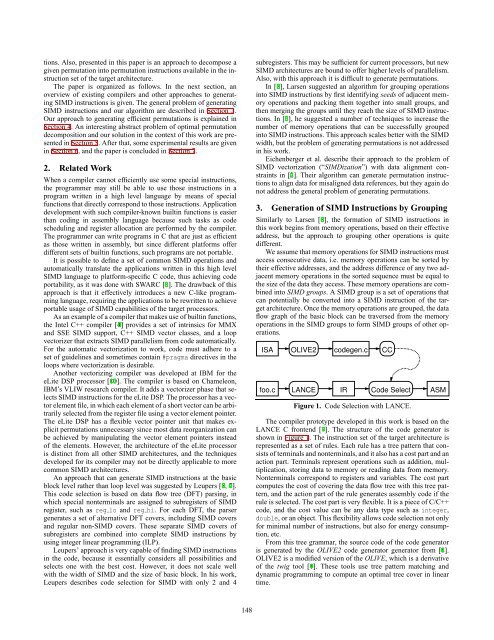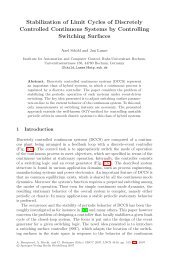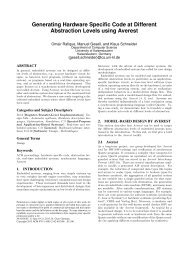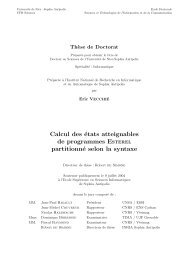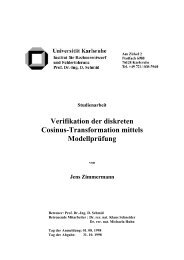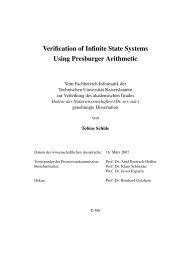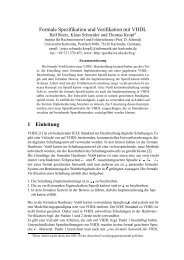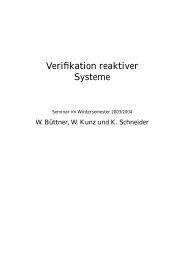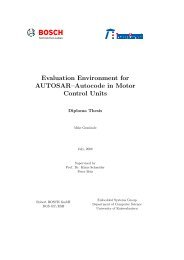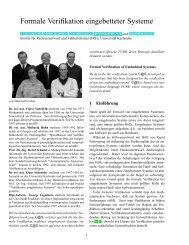Generation of permutations for {SIMD} processors - Embedded ...
Generation of permutations for {SIMD} processors - Embedded ...
Generation of permutations for {SIMD} processors - Embedded ...
You also want an ePaper? Increase the reach of your titles
YUMPU automatically turns print PDFs into web optimized ePapers that Google loves.
tions. Also, presented in this paper is an approach to decompose a<br />
given permutation into permutation instructions available in the instruction<br />
set <strong>of</strong> the target architecture.<br />
The paper is organized as follows. In the next section, an<br />
overview <strong>of</strong> existing compilers and other approaches to generating<br />
<strong>SIMD</strong> instructions is given. The general problem <strong>of</strong> generating<br />
<strong>SIMD</strong> instructions and our algorithm are described in Section 3.<br />
Our approach to generating efficient <strong>permutations</strong> is explained in<br />
Section 4. An interesting abstract problem <strong>of</strong> optimal permutation<br />
decomposition and our solution in the context <strong>of</strong> this work are presented<br />
in Section 5. After that, some experimental results are given<br />
in Section 6, and the paper is concluded in Section 7.<br />
2. Related Work<br />
When a compiler cannot efficiently use some special instructions,<br />
the programmer may still be able to use those instructions in a<br />
program written in a high level language by means <strong>of</strong> special<br />
functions that directly correspond to those instructions. Application<br />
development with such compiler-known builtin functions is easier<br />
than coding in assembly language because such tasks as code<br />
scheduling and register allocation are per<strong>for</strong>med by the compiler.<br />
The programmer can write programs in C that are just as efficient<br />
as those written in assembly, but since different plat<strong>for</strong>ms <strong>of</strong>fer<br />
different sets <strong>of</strong> builtin functions, such programs are not portable.<br />
It is possible to define a set <strong>of</strong> common <strong>SIMD</strong> operations and<br />
automatically translate the applications written in this high level<br />
<strong>SIMD</strong> language to plat<strong>for</strong>m-specific C code, thus achieving code<br />
portability, as it was done with SWARC [3]. The drawback <strong>of</strong> this<br />
approach is that it effectively introduces a new C-like programming<br />
language, requiring the applications to be rewritten to achieve<br />
portable usage <strong>of</strong> <strong>SIMD</strong> capabilities <strong>of</strong> the target <strong>processors</strong>.<br />
As an example <strong>of</strong> a compiler that makes use <strong>of</strong> builtin functions,<br />
the Intel C++ compiler [4] provides a set <strong>of</strong> intrinsics <strong>for</strong> MMX<br />
and SSE <strong>SIMD</strong> support, C++ <strong>SIMD</strong> vector classes, and a loop<br />
vectorizer that extracts <strong>SIMD</strong> parallelism from code automatically.<br />
For the automatic vectorization to work, code must adhere to a<br />
set <strong>of</strong> guidelines and sometimes contain #pragma directives in the<br />
loops where vectorization is desirable.<br />
Another vectorizing compiler was developed at IBM <strong>for</strong> the<br />
eLite DSP processor [10]. The compiler is based on Chameleon,<br />
IBM’s VLIW research compiler. It adds a vectorizer phase that selects<br />
<strong>SIMD</strong> instructions <strong>for</strong> the eLite DSP. The processor has a vector<br />
element file, in which each element <strong>of</strong> a short vector can be arbitrarily<br />
selected from the register file using a vector element pointer.<br />
The eLite DSP has a flexible vector pointer unit that makes explicit<br />
<strong>permutations</strong> unnecessary since most data reorganization can<br />
be achieved by manipulating the vector element pointers instead<br />
<strong>of</strong> the elements. However, the architecture <strong>of</strong> the eLite processor<br />
is distinct from all other <strong>SIMD</strong> architectures, and the techniques<br />
developed <strong>for</strong> its compiler may not be directly applicable to more<br />
common <strong>SIMD</strong> architectures.<br />
An approach that can generate <strong>SIMD</strong> instructions at the basic<br />
block level rather than loop level was suggested by Leupers [8, 7].<br />
This code selection is based on data flow tree (DFT) parsing, in<br />
which special nonterminals are assigned to subregisters <strong>of</strong> <strong>SIMD</strong><br />
register, such as reg lo and reg hi. For each DFT, the parser<br />
generates a set <strong>of</strong> alternative DFT covers, including <strong>SIMD</strong> covers<br />
and regular non-<strong>SIMD</strong> covers. These separate <strong>SIMD</strong> covers <strong>of</strong><br />
subregisters are combined into complete <strong>SIMD</strong> instructions by<br />
using integer linear programming (ILP).<br />
Leupers’ approach is very capable <strong>of</strong> finding <strong>SIMD</strong> instructions<br />
in the code, because it essentially considers all possibilities and<br />
selects one with the best cost. However, it does not scale well<br />
with the width <strong>of</strong> <strong>SIMD</strong> and the size <strong>of</strong> basic block. In his work,<br />
Leupers describes code selection <strong>for</strong> <strong>SIMD</strong> with only 2 and 4<br />
subregisters. This may be sufficient <strong>for</strong> current <strong>processors</strong>, but new<br />
<strong>SIMD</strong> architectures are bound to <strong>of</strong>fer higher levels <strong>of</strong> parallelism.<br />
Also, with this approach it is difficult to generate <strong>permutations</strong>.<br />
In [5], Larsen suggested an algorithm <strong>for</strong> grouping operations<br />
into <strong>SIMD</strong> instructions by first identifying seeds <strong>of</strong> adjacent memory<br />
operations and packing them together into small groups, and<br />
then merging the groups until they reach the size <strong>of</strong> <strong>SIMD</strong> instructions.<br />
In [6], he suggested a number <strong>of</strong> techniques to increase the<br />
number <strong>of</strong> memory operations that can be successfully grouped<br />
into <strong>SIMD</strong> instructions. This approach scales better with the <strong>SIMD</strong><br />
width, but the problem <strong>of</strong> generating <strong>permutations</strong> is not addressed<br />
in his work.<br />
Eichenberger et al. describe their approach to the problem <strong>of</strong><br />
<strong>SIMD</strong> vectorization (“<strong>SIMD</strong>ization”) with data alignment constraints<br />
in [2]. Their algorithm can generate permutation instructions<br />
to align data <strong>for</strong> misaligned data references, but they again do<br />
not address the general problem <strong>of</strong> generating <strong>permutations</strong>.<br />
3. <strong>Generation</strong> <strong>of</strong> <strong>SIMD</strong> Instructions by Grouping<br />
Similarly to Larsen [5], the <strong>for</strong>mation <strong>of</strong> <strong>SIMD</strong> instructions in<br />
this work begins from memory operations, based on their effective<br />
address, but the approach to grouping other operations is quite<br />
different.<br />
We assume that memory operations <strong>for</strong> <strong>SIMD</strong> instructions must<br />
access consecutive data, i.e. memory operations can be sorted by<br />
their effective addresses, and the address difference <strong>of</strong> any two adjacent<br />
memory operations in the sorted sequence must be equal to<br />
the size <strong>of</strong> the data they access. These memory operations are combined<br />
into <strong>SIMD</strong> groups. A <strong>SIMD</strong> group is a set <strong>of</strong> operations that<br />
can potentially be converted into a <strong>SIMD</strong> instruction <strong>of</strong> the target<br />
architecture. Once the memory operations are grouped, the data<br />
flow graph <strong>of</strong> the basic block can be traversed from the memory<br />
operations in the <strong>SIMD</strong> groups to <strong>for</strong>m <strong>SIMD</strong> groups <strong>of</strong> other operations.<br />
ISA<br />
foo.c<br />
OLIVE2<br />
LANCE<br />
codegen.c<br />
IR<br />
CC<br />
Code Select<br />
Figure 1. Code Selection with LANCE.<br />
ASM<br />
The compiler prototype developed in this work is based on the<br />
LANCE C frontend [7]. The structure <strong>of</strong> the code generator is<br />
shown in Figure 1. The instruction set <strong>of</strong> the target architecture is<br />
represented as a set <strong>of</strong> rules. Each rule has a tree pattern that consists<br />
<strong>of</strong> terminals and nonterminals, and it also has a cost part and an<br />
action part. Terminals represent operations such as addition, multiplication,<br />
storing data to memory or reading data from memory.<br />
Nonterminals correspond to registers and variables. The cost part<br />
computes the cost <strong>of</strong> covering the data flow tree with this tree pattern,<br />
and the action part <strong>of</strong> the rule generates assembly code if the<br />
rule is selected. The cost part is very flexible. It is a piece <strong>of</strong> C/C++<br />
code, and the cost value can be any data type such as integer,<br />
double, or an object. This flexibility allows code selection not only<br />
<strong>for</strong> minimal number <strong>of</strong> instructions, but also <strong>for</strong> energy consumption,<br />
etc.<br />
From this tree grammar, the source code <strong>of</strong> the code generator<br />
is generated by the OLIVE2 code generator generator from [8].<br />
OLIVE2 is a modified version <strong>of</strong> the OLIVE, which is a derivative<br />
<strong>of</strong> the twig tool [1]. These tools use tree pattern matching and<br />
dynamic programming to compute an optimal tree cover in linear<br />
time.<br />
LCTES’05, 2 2005/4/16<br />
148


